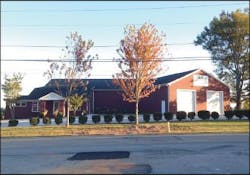When it comes to keeping employees safe while completing aluminum repairs, Scott Larson says it’s not much different than your normal sanding, grinding and cutting on standard metal bodies.
Except for one key factor: the dust.
Aluminum dust, says Larson, 3M’s personal safety division’s technical service manager, owns a much higher combustion rate than most metal particles. It poses a breathing concern as it is very light and floats in the air longer than most metal dust, and fine amounts of powdered aluminum-magnesium alloy (used in the Ford F-150) are subject to explosions—especially when in the same vicinity as steel.
So while a report from the Aluminum Association’s Aluminum Transportation Group states there has never been an explosion at a body shop, Larson says it’s important to understand all of the equipment and precautions required to reduce safety concerns as aluminum use in vehicles continues to rise in prevalence.
“Unfortunately, a lot of shop owners and employees don’t know what it is they really need until someone gets hurt or someone comes in and slaps them with a fine,” Larson says.
FenderBender spoke with four body shop safety experts on how to meet several OSHA recommendations for managing dust and reducing explosion risks while grinding and cutting aluminum.
1. Implement a hazardous dust inspection, testing, housekeeping and control program.
Before implementing aluminum repair in your shop and instituting a dust control program, it’s important to evaluate your space and activities. Joe Kenny, president of Safety Regulation Strategies Inc., says to document all the hazards of the tasks technicians will perform.
“If they’re doing grinding, cutting, sawing, then that’s going to primarily present an eye hazard; if they’re touching hot or sharp parts, that’s going to require hand protection; and then any grinding or welding will require respiratory protection,” he says.
In order to stay ahead of OSHA requirements, Kenny recommends creating written documentation of all potential safety hazards and the steps you take to avoid them by purchasing specific equipment and attending safety training. He also suggests keeping track of all your equipment’s inspection schedules and performing regular check-ups to make sure everything is working properly. He says there are many companies like Safety Regulation Strategies that assist with these documents and preparations.
“To minimize or eliminate the hazards, you have to list the steps you’re going to take,” he says. “‘I’m going to engineer that hazard away through ventilation,’ or ‘I’m going to put a barrier between the individual and the hazard in the form of personal protective equipment.’”
For the most obvious potential health hazards, Kenny says to purchase and keep an inventoried list of personal equipment protecting technicians’ eyes and skin and respiratory systems. Luckily, this equipment—such as welding goggles, gloves and respirators—should already be in stock for any shop performing any kind of welding.
2. Minimize the escape of dust from the process equipment or the ventilation systems.
Frank Cea, marketing director for RoboVent, says it’s important to evaluate your facility’s structure to determine how air flows throughout the shop and how aluminum dust travels so you can regulate it—which will aid in meeting three other OSHA requirements:
- Inspect for dust residues in open and hidden areas at regular intervals.
- Provide access to all hidden areas to permit inspection.
- Locate relief valves away from dust deposits.
This task can be tough to perform on your own, so Cea recommends asking an equipment supplier to provide some help.
“The principles of air movement are the same wherever you go. Indoor air quality principles are the same regardless if it’s a shop or the inside of your home,” he says. “You just need to know the right type of equipment, where to place things, and what your airflow patterns are within your facility. Then you know exactly where to place the equipment, and can spend the least amount of money doing it.”
3. Control mechanical sparks and friction.
In addition to airflow, OSHA recommends controlling ignitions around the shop. When evaluating your shop layout and documenting equipment related to your aluminum repairs, Kenny says to work with equipment manufacturers or safety regulation companies to note any electrical hazards that keep in line with these OSHA recommendations:
- Use appropriate electrical equipment and wiring methods.
- Control static electricity, including bonding of equipment to ground.
- Separate heated surfaces and systems from dusts.
If fire or sparks are produced during riveting, welding or burning, then OSHA requires shops to obtain a “hot work permit.” To prevent sparks, Kenny says to apply water during the grinding process.
Some extractors come with a spark indicator, which triggers the vacuum system whenever a welder strikes a spark.
“It will run for about 40 seconds and get any excess fumes and smoke out of there, and then it automatically shuts off,” says Richard Perry, OEM and strategic account sales manager for Chief Automotive Technologies. “It saves the technician from having to go back and forth, or having to hear it the whole time he’s adjusting the pin or things like that.”
4. Use separator devices to remove foreign materials capable of igniting combustibles from process materials.
When an aluminum particle and a metal oxide are ignited by a heat source, the reaction is akin to fireworks, says Larson. To avoid this reaction, which occurs when a grinder is used on steel prior to aluminum, you should separate steel and aluminum work.
There are two options for creating an alternate space for aluminum grinding: curtains or walls. Curtains are the more affordable option, with the least expensive curtains costing around $1,113 (according to Ford’s pricing forecast), and separate rooms coming in over $26,000.
While Kenny says curtains provide sufficient separation, many shops will opt to create entirely separate units. It’s a bigger expense, but surrounding aluminum repairs with walls allows you to better regulate the airflow and ensures separation between steel and aluminum.
5. Use proper dust collection systems and filters.
According to Perry, you’ll need systems that extract dust particles and fumes away from where aluminum repairs are performed.
“As more and more shops implement aluminum, I can see this becoming very important for separating aluminum dust from steel,” he says.
Perry says you can choose between a central or a mobile vacuum system.
“With a mobile system, you can move it anywhere in the shop and get it close to where you’re working,” he says. “It has a boom you can place over your work area and it pulls the fumes straight up.”
Another option, Perry says, are dust extractors that come with a water filtration system, which don’t require you to clean or replace filters, but instead simply swap in clean water.
“Everything that gets pulled through the vacuum is forced down into a funnel and through a pool of water, so any particles are going to be put into the water,” he says. “It’s picking up any solids, any dust particles. And then there’s a trap inside the water area for cleaning it out.”
According to a pricing forecast, Ford created for dealerships implementing aluminum repair spaces for the 2015 Ford F-150, dust collecting systems cost anywhere between $10,125 and $17,999.

